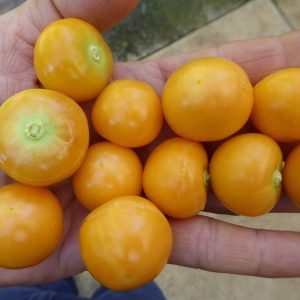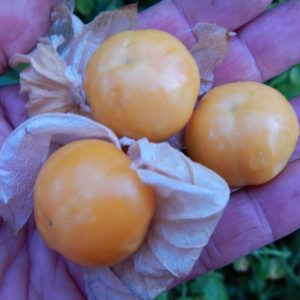Physalis peruviana
Cape gooseberry, golden berry, Inca berry
Origin
Native to high-altitude, tropical Peru, Colombia, and Ecuador, and since grown in most of the warm areas of the world.
Climate
The cape gooseberry is an annual in temperate regions and a perennial in the tropics up to 3000m elevation but can still tolerate a mild frost. Mean precipitation can be 800-3000mm pa, but this needs to be distributed mainly during the growing season, with very little when fruits are maturing. It will not tolerate water-logging.
Plant Description
A herbaceous, soft-wooded, perennial plant that grows to a metre or more in height with densely pubescent and ribbed, often purplish branches. It has ribbed, spreading branches, and nearly opposite, velvety, heart-shaped, randomly-toothed leaves on 2-5-5cm petioles. The lamina is broadly ovate, 6-15 x 4-10cm, densely pubescent and with mostly an entire margin.
Relatives
Solanaceae Family. Relatives include tomato, tamarillo, tomatillo, and many others.
Soils
Any well-drained soil, but does best on sandy to gravelly loam. If soil fertility is high, there is much vegetative growth at the expense of the fruits. Plants tolerate a pH in the range 4.5 to 8.2.
Propagation
Usually seeds. Superior plants can be started from 1-year-old stem cuttings, or, less often, air layering.
Cultivars
There are superior selections and a few named varieties.
Flowering and Pollination
The hermaphrodite flowers and are pollinated by bees and wind. They are yellow with a dark centre, bell-shaped, 2 cm wide, capped by a purplish-green, hairy, 5-pointed calyx. After the flower falls, the calyx expands, forming a straw-colored husk much larger than the fruit it encloses.
Cultivation
Plant in full sun and protect from wind. Plants need water during the growing season but little while the fruits are maturing.
Wind Tolerance
Needs protection from strong winds.
Pruning
When fruiting is finished, prune back rather severely.
The Fruit
The juicy fruit is a berry enclosed in a papery-thin chartaceous calyx, up to 5cm in diameter, contains 5-10 small seeds and changes from green to yellow-orange with maturity. The berry can grow to 2cm or 3cm in diameter. It has a good protein level for a fruit and is rich in vitamins A and C with a carbohydrate content of 11-16%. The flavour is a curious blend of tart and sweet, with other side notes. The pulp, separate from the skin and seeds, represents about 73% of whole fruit weight.
Fruit Production and Harvesting
They begin bearing in their first year. If pruned after fruiting, they can live and produce for several more years. Fruits are picked by hand every 2 to 3 weeks, or they can be shaken off the bush and collected on the ground. They have good keeping qualities. Fruits in their husks can be dried in the sun, and will turn into a product much like raisins.
Fruit Uses
Eaten fresh or dried, made into jams, chutneys, fruit salads and many desserts. Do not eat unripe fruit or the papery husk.
Pests and Diseases
Cutworms, spider mites, scale, powdery mildew. Also prone to the same problems as local tomatoes and potatoes. Fruit left on the ground is appreciated by many insects and other small creatures.
Comments
Cape gooseberry was brought to Australia in the very early colonial days, from South Africa (the Cape). It was often the only fresh fruit the settlers had, and fortunately, it was easy to grow.


